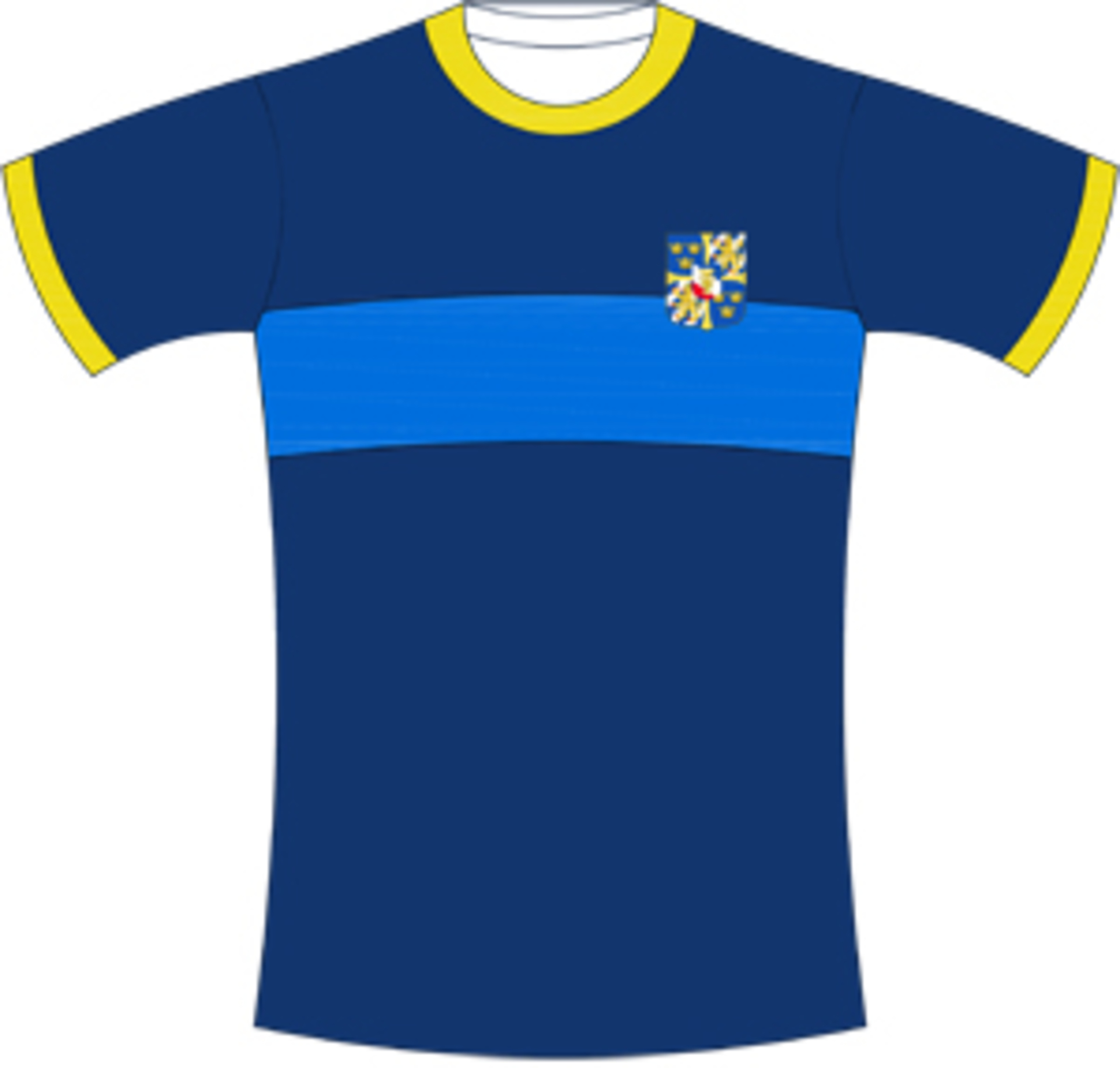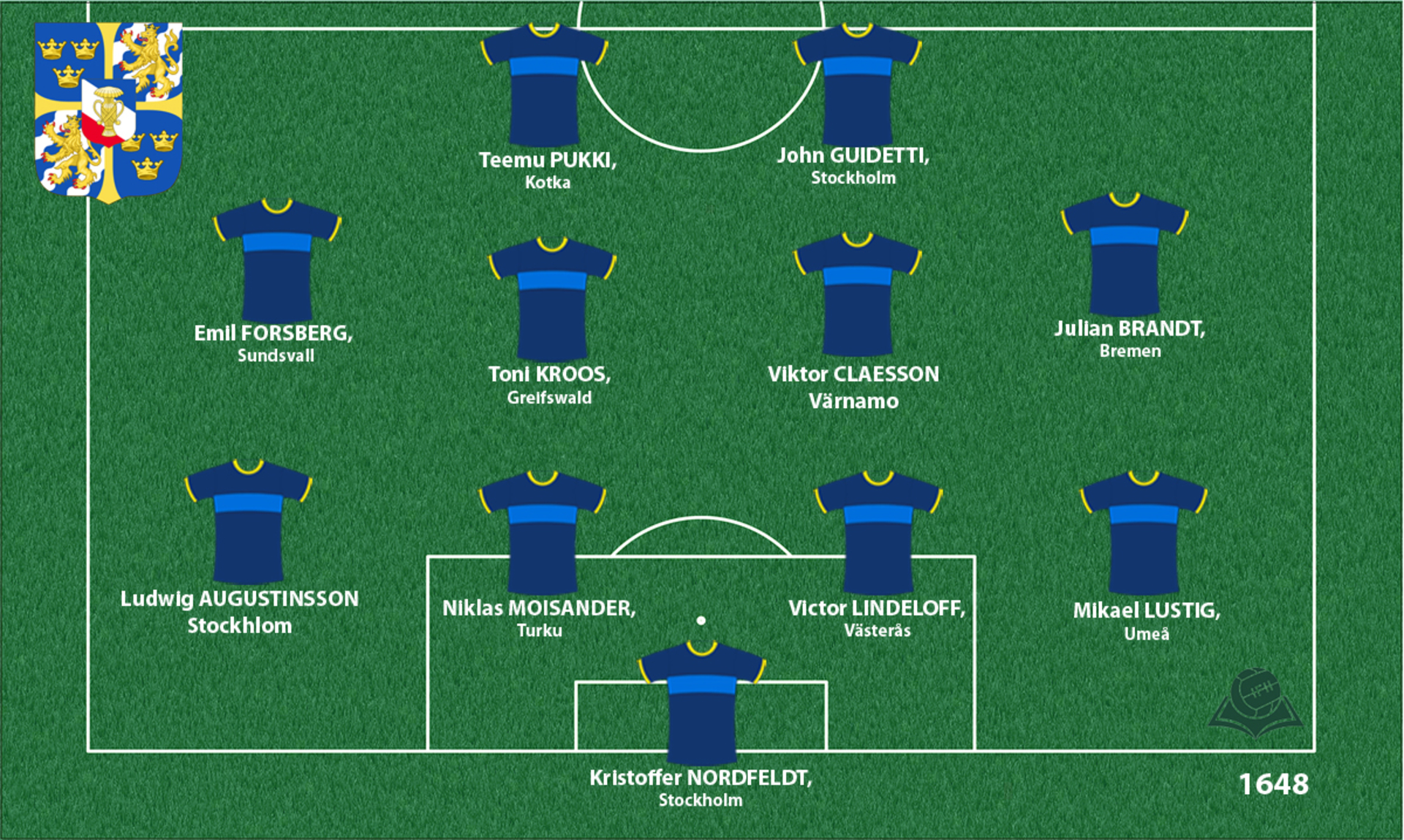The Kingdom of Sweden
The main characteristic of Sweden in the early phase of the Vasa dynasty (ruled 1523 – 1654) is that of a strong monarchy, albeit with rural and backward economy. Its greatest weaknesses lay in the rebellions of the high nobility, and the constant desire for reprisals against Denmark. The period between 1560 and 1720 was full of conflicts between Sweden and Denmark about who was going to be the leading power in the Baltics, and was be markedby six years-long wars between the two.

Coat of arms

Shirt
| Position | First name | Last name | Mjesto rođenja | Like | Dislike | |
|---|---|---|---|---|---|---|
| GK | Felix | WIEDWALD | Thedinghausen |
0 |
1 |
|
| GK | Kristoffer | NORDFELDT | Stockholm |
0 |
0 |
|
| DC | Aleksander | MILOŠEVIĆ | Sundbyberg |
0 |
0 |
|
| DC | Karl | ARNASSON | Göteborg |
0 |
0 |
|
| DC | Niklas | MOISANDER | Turku |
0 |
0 |
|
| DLC | Ragnar | KLAVAN | Viljandi |
4 |
0 |
|
| DR | Mikael | LUSTIG | Umeå |
1 |
0 |
|
| DL | Ludwig | AUGUSTINSSON | Stockholm |
1 |
0 |
|
| DL | Oscar | WENDT | Göteborg |
0 |
1 |
|
| DL/ML | Martin | OLSSON | Gävle |
0 |
0 |
|
| DC/DMC | Victor | LINDELOF | Västerås |
4 |
0 |
|
| MC | Albin | EKDAL | Stockholm |
0 |
0 |
|
| MC | Jakob | JOHANSSON | Trollhättan |
0 |
0 |
|
| MC | Oscar | HILJEMARK | Gislaved |
0 |
0 |
|
| MC | Simon | TIBBLING | Stockholm |
0 |
0 |
|
| MC | Toni | KROOS | Greifswald |
14 |
1 |
|
| MRC | Viktor | CLAESSON | Värnamo |
0 |
0 |
|
| AMC | Robin | QUAISON | Stockholm |
0 |
0 |
|
| AMRLC | Arber | ZENELI | Säter |
0 |
0 |
|
| AMRL | Emil | FORSBERG | Sundsvall |
3 |
0 |
|
| AMRL | Sam | LARSSON | Göteborg |
2 |
0 |
|
| AMRL | Sebastian | LARSSON | Eskilstuna |
0 |
0 |
|
| FRLC | Alexander | ISAK | Solna |
0 |
0 |
|
| FC | Joel | POHJANPALO | Helsinki |
0 |
0 |
|
| FC | John | GUIDETTI | Stockholm |
2 |
0 |
|
| FC | Marcus | BERG | Torsby |
0 |
0 |
|
| FC/SS | Ola | TOIVONEN | Degerfors |
0 |
0 |
|
| FC/SS | Teemu | PUKKI | Kotka |
3 |
0 |
(Today part of Sweden (without Scania, Finland, Estonia, parts of northern Germany)
Seen as how all Scandinavian elites accepted Lutheranism in the times of the Reformation, the first half of the 17th century was marked by their engagement in the Thirty Years’ War, whose consequence was that Sweden grew into a great European power. At the same time, the attempts of the king of Denmark to become a leader of all Protestant states ended in failure, which proved to be fatal for the king’s ambitions and Denmark as a whole. Sweden, under Gustav II Adolf (ruled 1611 – 1632) had, by 1648, put under its domain parts of Pomerania and parts of the Duchy of Bremen, alongside previously conquered strategic points in the Baltics i.e. Eastern Karelia, Ingria, and Livonia. Several years afterwards, Sweden had expanded once again at the cost of Denmark (the First Northern War 1654 – 1660), permanently occupying Skane, Halland, and Blekinge. Taking advantage of the Polish-Russian war (1655), the king of Sweden took a large portion of Polish territory.
Altogether, this had secured Swedish control of the passage between the North and the Baltic sea, as well as control of the estuaries of all rivers from the Neva to the Weser, with the exception of the Vistula, and enabled them to collect taxes in all ports from the Narva to the Wismar. Trade companies were established, modelled on those in the Netherlands, and the merchant navy was expanded. Swedish copper dominated the European market, and the production of iron and military industry were at their peak.Nevertheless, the impression of grandeur depended to a great extent on the weakness of their great rivals. As early as the end of the century, Sweden’s power began to slowly diminish due to constant wars against Denmark,Russia, the Netherlands, and Brandenburg, which led to the increase of government debt, and a hard financial situation, but it was also due to the long-standing struggle of the Swedish peasantry against the nobility, who had appropriated almost two thirds of arable land and forests.
Sources
- Felipe FERNANDEZ-ARMESTO, Narodi Europe, Zagreb, 1997.
- Grupa autora, Povijest: Počeci novog doba (16. stoljeće), knjiga IX., Zagreb 2008.
- Grupa autora, Povijest: Doba apsolutizma (17. stoljeće), knjiga X., Zagreb 2008.
- 'Denmark'', http://denmark.dk/en/~/media/Denmark/Documents/Society/History-2003-en.jpg
- ''Sweden: Viking age'', https://www.britannica.com/place/Sweden/The-Viking-Age
- ''Švedska'', http://www.enciklopedija.hr/Natuknica.aspx?ID=60070
- Coat of Amrs: https://en.wikipedia.org/wiki/House_of_Vasa#/media/File:Arms_of_the_House_of_Vasa.svg
